What’s next for payroll?
The government has ambitious plans to help people better manage their employment tax obligations through advanced digital technology. NZBusiness looks at the impact this will have on payroll processing, as well as other payroll developments business owners should be up to speed on.
The government has ambitious plans to help people better manage their employment tax obligations through advanced digital technology. NZBusiness looks at the impact this will have on payroll processing, as well as other payroll developments business owners should be up to speed on.
By Glenn Baker.
Ah, payroll! The bane of accounts people and business owners everywhere when things go wrong. So much to get your head around; so many changes in legislation to keep abreast of! Then, once in a generation, the government comes along and proposes huge changes to the way things are done, promising us a ‘smooth transition’ – which we know almost never happens. Who can forget Novopay!
The very nature of payroll determines that there will always be change. In recent times change has been created by the continued trend of moving payroll and employee management systems to the cloud – for most this has indeed proved to be a smooth transition.
Mobility also continues to drive innovation as smartphones become more prevalent and powerful.
However, Inland Revenue is embarking on a seven-year, $1 billion transformation project to not just replace the systems that administer tax in this country, but fundamentally change processes, policy, and how we all interact with the IRD going forward.
2016 and beyond holds a number of significant changes which will directly impact payroll processing. These include the proposed changes to the processing and payment of PAYE through the Tax Administration Act, a refocusing on record keeping through the Employment Standards Legislation Bill, and while not directly payroll related, the upcoming changes to Workplace Health and Safety from April 1st should mean a greater requirement for employee-related record keeping.
Clearly, if implemented, the proposed changes to PAYE, will have the most impact.
“Under the proposed changes currently in the consultation phase, it’s intended that businesses will be able, or forced, to lodge their PAYE returns electronically, directly from their payroll system,” explains Steve Nathan, Crystal Payroll’s sales and marketing director. “There’s also a suggestion that this would be done on a pay period basis rather than the current once or twice monthly, and a possibility businesses will need to have their payroll communicate directly with the IRD’s back-end systems and make the payment of PAYE on the same basis – that is, weekly. “This is where cloud based solutions will come into their own.”
Nathan can see the logic from the IRD’s perspective in that there’ll be more accurate reporting and timely collection of PAYE, but thinks employers could face greater compliance costs, and in many cases will need to upgrade their payroll systems. “Given the fact that many businesses still run desktop payrolls, or worse still, do it manually, the transition to such a new reporting and payment regime could see a hodgepodge of systems. Which means a long lead-in before IRD sees any real benefits,” he says.
Chris Mar, manager strategy and compliance for Datacom, believes the key to the way forward is the importance of payroll software in providing the mechanism by which IRD will be able to both receive and provide information to the employer, reducing the chance of mistakes and improving the timeliness of information. “A view of the future would see that interaction with IRD become more naturally embedded in the small business owner’s broader processes,” he explains. “So if you’re running your payroll, for example, you’d be interacting with IRD at the same time, without having to jump out and go onto a separate website to upload a file or fill in a form.
“So one of the key things business owners can do to prepare for the upcoming changes will be to make sure they use payroll software from a reputable vendor.”
Commenting on the Employment Standards Legislation Bill, still before Parliament at the time of writing, Mar says it will push through a wide range of changes, but in particular there is a focus on ways to improve employers’ compliance with minimum employment standards around areas such as minimum wage, record keeping and holiday payments.
“The bill gives greater powers to labour inspectors investigating breaches in minimum employment standards and an increase in the penalties that can be applied against employers involved in serious breaches of employment legislation.”
Mar says it will be interesting to see how these new powers will be applied, but emphasises the importance of making sure your payroll systems provide you with the tools, reports and assistance necessary to look out for issues. “We see this focus will only increase the use of payroll intermediaries to help manage tax compliance and/or payroll bureaus to offer an additional level of assistance and assurance to small business owners.”
Steve Nathan, meanwhile, sees the bill impacting on employers whose staff work variable hours.
“This refocusing is the result of issues in industries such as horticulture, viticulture and farming, to name a few, where in some cases record keeping has been lax, if not non-existent. The impact is that employers must keep daily records of the date worked, hours worked/leave paid and amount paid.
“While these records could be kept via manual systems such as time-sheets, the requirement will be that they be produced on demand. This is much harder where they are not stored electronically. Employers affected by this, even if using payroll systems, may have to consider updating their systems to track data daily, rather than the typical lump sum weekly data entry they do now,” says Nathan.
Warning bells
While the proposals outlined in the IRD’s transformation project are far reaching, it’s important to remember that consultation on those proposals don’t close until the 12th of February. That consultation process may throw up a number of red flags.
Martin Gleeson, managing director of cloud-based payroll provider iPayroll, was one who took the time to submit feedback, and his view is that the transformation project is overly ambitious, likening it to going “from a bicycle to a Ferrari in one fell swoop”.
“These types of large government projects have a high level of failure because they try to do too much, too soon,” he says.
Gleeson suggests smaller incremental changes would work better in migrating from the old platform to a new one. “Improvements that make sense.” He’s concerned at the prospect of making wholesale changes to the fundamental way the industry operates.
“When the market and industry are transformed, and we are better off, then that would be the time to consult on the big changes being mooted.”
Gleeson can envisage a move away from payroll service providers to end users – SMEs doing all the work themselves “using the IRD’s call centre to resolve the myriad of variations that happen with every cycle of payroll”.
“Currently, we and our customers have the comfort of knowing that when we submit our twice-monthly filings and payments for larger employers, and monthly filings and payments for smaller employers, the two parts reconcile properly, with variations already dealt with.
“Under the proposed model this would all change. The relationship would move away from the service provider to the SMEs and IRD directly on a daily payroll-by-payroll basis.”
The IRD’s help desk would have to be significantly beefed up for that to happen, he believes.
Payroll pointers
One thing is certain – the need for payroll providers will always be there, and no payroll article would be complete without advice on how to choose the best payroll solution and provider for your business.
Doug Jopling, CEO of IMS Payroll, says the number of payroll solution options in the marketplace is growing, but there’re some simple rules a business can apply to ensure they choose the right solution for their needs.
“Firstly, choose a company that’s been providing payroll solutions in New Zealand for a long time. You need a provider familiar with both the complex payroll system in this country and employer obligations.
“Next, consider what your key requirements are for your payroll system and ensure the solution you choose can cater for those requirements. For example, how many employees do you have? Do you want to work on the go, from any device or just from your office desktop PC? Do you want your payroll software to talk to your accounting software?
“Thirdly, ensure you’ll be backed up with reliable support from the software provider.”
A system should be flexible and configurable as every business is unique, continues Jopling. For smaller companies ease of use may be the most important aspect while other companies may require the payroll solution to integrate with timeclock/roster systems, financial systems or full HR systems.
“Another part of having a flexible configurable solution is being able to turn on and off required functionality to customise the solution to suit the particular requirements of the business,” Jopling says. “A business should choose a payroll solution that can grow with the business, which means less disruption in the long term and saves time and money – staff will not need to retrain for a new solution further down the track.”
One of the trends Jopling has witnessed is the desire to have an employee self service module. “Our employee self service module allows employees to submit leave requests online (via Internet-enabled devices, including smartphones) and email notifications allow quick and easy approval by managers. Approved leave is automatically submitted into our payroll system, eliminating data entry and errors and reducing paper and manual filing. Employees can also view payslips and personal details and managers have access to reporting tools to manage their team’s leave and costs.”
Steve Nathan is forthright when it comes to advice.
“Make sure you ‘purchase a system’ and you’re not ‘sold’ one,” he says. “We often see smoke and mirrors presentations where the product or marketing material looks great – but ask yourself, what’s behind the business? How long have they been around? Is their ‘cloud’ solution really a cloud solution or a rehashed PC solution?
“Do due diligence. Make a list of everything you ‘need’, everything you would ‘like’, and then make sure the provider can show you these things.”
While price is important, it’s not everything, Nathan says. “There’re three key components to new payroll systems – price, functionality and service, and generally the only way to reduce one of the components – namely, price – is to reduce one or both of the others.”
Datacom’s Chris Mar says it’s important to use all the features your payroll solution has to offer. “If a self-service option exists, use it so that your staff have access to the information that they need, without having to come and ask you for it,” he says. “Make use of the tools that monitor for changes, especially around employees that work irregular hours. These employees are always trickiest to manage around leave and what they’re entitled to.”
The future of payroll
As mentioned earlier, change is inevitable in the payroll space. Steve Nathan, with his 20 years’ industry experience, has seen it all. He finds the recent arrival of the cloud, with its ability to more readily distribute and capture data, the most exciting aspect and the way forward.
“Added to this is the rapid growth in mobile connectivity, which sees payroll managers being able to focus more on management of the company’s payroll needs rather than just data entry. “It’s something they should embrace,” he says.
Another related area he believes will become more common is cloud-based time and attendance systems which will again speed up the payroll process and improve accuracy.
“The main thing is to embrace technology and use it as a tool to better manage the payroll process,” adds Nathan. “Just because you’ve ‘always done it this way’ doesn’t mean it’s the most efficient or cost effective way to do it.
“Take time to step outside your day-to-day operation and look at your options. There’re plenty of people in the payroll industry who can help a business owner perform a system analysis which will identify improvements.”
Depending on the size of the business, Nathan also believes in putting responsibility for managing the payroll as close to the coalface as possible.
“This means having employees or line managers being responsible for as much data entry as possible, which leaves the payroll manager only needing to verify data, rather than enter it.”



